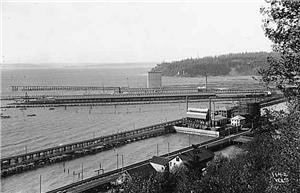The quality of life for the hill folk living along the sides and summit of Queen Anne Hill has periodically been threatened from below. A 1996 hubbub over unloading acres of foreign automobiles onto Interbay's parking lots was preceded by more than a century of railroad racket climbing the western slope of Queen Anne Hill. In 1903, the Great Northern laid its Seattle yard down below.
But the peace, quiet, and clean air of the Queen Anne milieu was peculiarly threatened at the beginning of the twentieth century when the Citizens Light and Power Company started to drive piles for a gas plant just off-shore in Smith Cove. Since the manufacture of gas from burning coal is a notoriously foul process, the residents of Queen Anne Hill had a right to be wary. Fortunately they also had the political clout to win.
Although the gas plant was eventually built --it appears in the "then" view -- it was only at the expense of the company's installing the first down draft smokeless boiler furnaces used on the Pacific Coast. With this innovation the plant spewed neither smoke nor smell, and since its height was not so reaching as to intrude on another of Queen Anne's environmental treasures -- its view of the Olympic -- the gas plant was a good neighbor. (Nearby, years later, the Port of Seattle's much taller grain elevator did screen this view, despite Queen Anne's objections.)
Curiously, flaunting a variety of life-or-death hysteria, the plant's innovations were cited by the Citizen Company's business rival, the Seattle Gas and Electric Company, in its attempt to stop its new competitors from laying pipe into the older company's preserve: the Central Business District. The Seattle Gas and Electric Company claimed that the new gas from Smith Cove was more lethal and so responsible for the slew of gas-suicides reported in the papers.
In fact, investigators determined that the city's desperate self-destroyers did not discriminate in their choice of gas and were taking it from both pipes.

